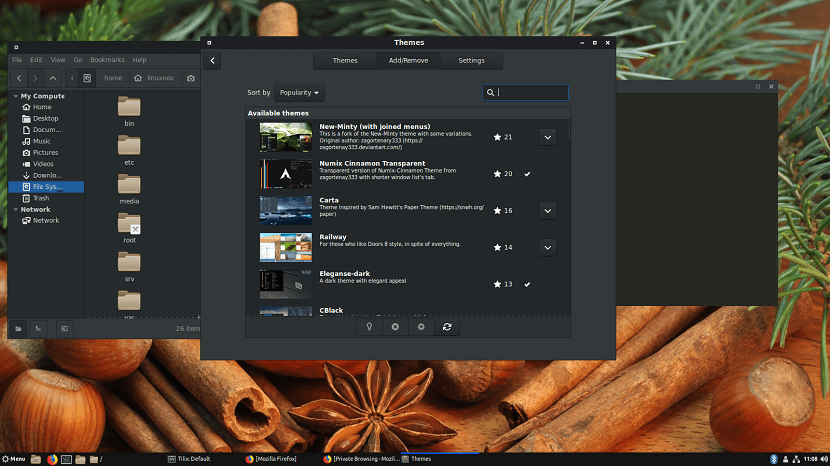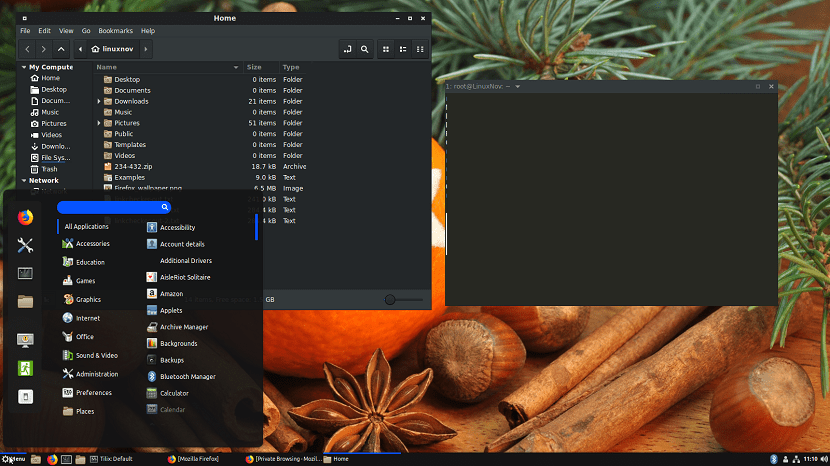
Cinnamon is a free and open source desktop environment based on GTK. Cinnamon was first introduced in Linux Mint as one of the default desktops for each version.
Cinnamon's desk It comes with a friendly user interface with many customization options through the System Settings window.
The system configuration includes configurable installation options for the Cinnamon desktop, themes, hot corners, applets, workspaces, launchers, and more.
The beauty of using Cinnamon is that it makes it easy to customize desktop themes, applets, extensions, and desklets.
Additionally, highly rated Themes, Applets, Extensions and Desklets can be downloaded from System Settings and activated with one click. No need to install any additional tools or packages.
The desktop environment consists of several key components, such as:
- The window manager, which determines how windows appear and behave.
- A menu
- A task bar
- Icons
- File managers
- Other tools that, in a nutshell, allow you to use your computer
The Cinnamon desktop is much more like Windows, so if you are Windows users, you will probably find Cinnamon particularly easy to use.
How to install Cinnamon desktop environment on Ubuntu and derivatives?
One of the easiest ways to install this desktop environment on our system, it is with the help of our software center.
So just open it and search for "Cinnamon" it will appear in the search and just install.
Or from a terminal, which we can open with the shortcut Ctrl + Alt + T. We can type the following command:
sudo apt-get install cinnamon
This would be the simplest way.

Although, as you will know, the packages found within the Ubuntu repositories most of the time are not the most current and when it comes to a desktop environment they don't always add all the add-ons to it.
So almost always It is advisable to use a repository of the environment where we will not only obtain the most current versionl, but also the packages that are complements of the environment and we will also have the updates more quickly.
Installation from PPA (Ubuntu 18.04 and lower)
For those who prefer to install the environment by this means, Users of Ubuntu 18.04 and derivatives can do so, as well as previous versions that still have support (LTS).
We can add the repository to our system, opening a terminal with Ctrl + Alt + T and on it we are going to type the following command:
sudo add-apt-repository ppa:trebelnik-stefina/cinnamon
Once this is done, now we are going to update our list of packages and repositories with:
sudo apt-get update
And finally we can install the environment with the following command:
sudo apt-get install cinnamon
Installation from PPA Ubuntu 18.10 and derivatives
In the special case of users of the latest stable version of Ubuntu at the moment, which is 18.10, we will obtain the environment in the same way. Only we will make some adjustments.
Because the repository only supports up to 18.04 and if we follow the previous steps we will get a "404" error in the terminal as it will indicate that the "Cosmic" repo does not exist.
In this case what we are going to do is edit our sources.list or they can add the repository graphically from "Software and Updates", in the "other software" tab> add.
Here we add the following:
deb http://ppa.launchpad.net/trebelnik-stefina/cinnamon/ubuntu bionic main deb-src http://ppa.launchpad.net/trebelnik-stefina/cinnamon/ubuntu bionic main
Or from the terminal we are going to type:
sudo nano /etc/apt/sources.list
And at the end we are going to add:
deb http://ppa.launchpad.net/trebelnik-stefina/cinnamon/ubuntu bionic main deb-src http://ppa.launchpad.net/trebelnik-stefina/cinnamon/ubuntu bionic main
We save with Ctrl + O and close with Ctrl + X. Next is to add the public key of the repo with:
sudo apt-key adv --keyserver keyserver.ubuntu.com --recv-keys CFB359B9
Once this is done, now we are going to update our list of packages and repositories with:
sudo apt-get update
And finally we can install the environment with the following command:
sudo apt-get install Cinnamon
In the end, you just have to close your user session and start with the new environment.
Are you sure there is no "residue" left if I use the gnome environment again in Ubuntu 18.04 ?, I have already installed other desktop environments in Ubuntu and there are always "things" that finally force you to reinstall everything again.
In this case, both Gnome and Cinnamon use some libraries since as you know Cinnamon is a fork of Gnome. So in this case, if you have some Cinnamon or Gnome packages left.
Is there a way to install it throughout the OS and not as a secondary graphical environment?
And in case of problems, how do I uninstall it?